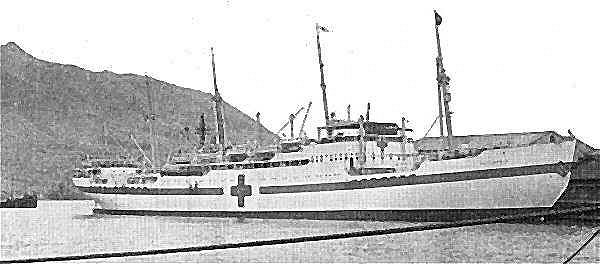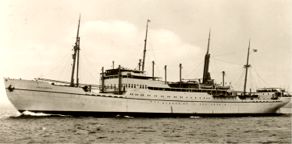|
You are here: 4Campaigns & Battles4Index4The JUTLANDIA Expedition |
|||||||||||||||||||||||||||||||||||||||||
|
The JUTLANDIA Expedition (1951-1953):
Somebody just
|
||||||||||||||||||||||||||||||||||||||||
|
The motives for Tove, wasn't that of an adventurer either. – When coming from the south of Jutland, you have a special relation to suppression. And in Korea, somebody obviously needed my assistance as a nurse, she says. – It was in the nick of time, that I got to go, because I was one of the youngest. For such an assignment, they rather wanted mature nurses. The average age was around 40, which was properly just, but there was a great interest to come along on the assignment. When they needed 30 nurses for the JUTLANDIA, 200 applied for the job. |
Foreign
Minister, Ole Bjørn Kraft |
Four nurses in each cabin
The payment-procedures on board were very special for the hospital crew. No one could have more than 600 Danish Kroners a month. The rest of the pay was paid to them when they came back to Denmark.
The crew of the ship, sailed on the usual agreement between EAC and the Danish Shipping Association.
Four nurses lived in each of the former passenger cabins, so privacy was very scares.
Even though JUTLANDIA had been rebuilt to an overcrowded field hospital, it was still a elegant ship with its beautiful salons, plenty of mahogany, chandeliers and maritime pictures on the walls.
But the ship was already old at that time – from 1934, and it was a tough job to keep the engines running, even if, as Svend remembers, the engines was excellent engines.
The two five cylinder diesel engines, manufactured by Burmeister & Wain, gave away 7850 hp, which gave the ship a speed of 15 knots.
When it sailed from Copenhagen in 1951, JUTLANDIA was properly the most modern of hospitals.
There were several state-of-the-art operating rooms on board, and some of the most famous surgeons of that time was hired – unfortunately only for a couple months at a time.
In her own, JUTLANDIA contributed to new chapters in the advancement of medical history. Disposable equipment, artificial kidneys and equipment to transplant kidneys, new kinds of eye surgery, new treatment procedures for burn victims and so on.
– As a nurse, one learned to act and work in a new, and completely different manner, Tove Jagd says.
– If we received a patient in filthy and bloody clothes, we just cut the clothes of him, and then it was off to the operating table.
The Helicopters
|
The
JUTLANDIA
got a helicopter |
She remembers vivid when the ship got its own helicopter landing platform. The ship was therefore directed close to the coast - and the front. The wounded soldiers were transported on stretchers, which was mounted on the helicopters fuselage. This lead to that the soldiers could sometimes be on the operating table as fast as 20 minutes after they were injured. Some of them even received a blood transfusion during the transport in the helicopter. At night, the crew could see the lights from the shells, when the fighting went back and forth in land. In this way, they were mobilized and ready to receive wounded personnel, even before they came. |
In the entire time, when serving as a hospital ship, "only" a dozen patients died on the JUTLANDIA, says Svend and Tove Jagd. It was a grateful job to work with these young wounded soldiers, because they were young and fit, so they recovered pretty fast from their injuries.
– I remember a young American soldier, that had been so badly burned by a flamethrower, that we were convinced he wouldn't survive.
When I came to his bed the next morning, it was empty, and I thought that he had probably died. But it turned out that he was lying on a stretcher in the cinema with a intravenous needle. He later recovered nicely, Tove says.
Svend thinks that the camaraderie that occurred between the soldiers, has helped them through a lot of pain.
– They were depending on each other, and they felt that they were fighting for a greater cause.
Few people are thinking about, that in the three years of the war in Korea, the casualties was the same as the ten years of fighting in Vietnam.
The war in Korea would cost almost three million killed and over three million wounded.
Fragile children
Tove and Svend believes, that it has a great effect on the future, not to mention the Korean's understanding of JUTLANDIA, that it as the only hospital ship during the war, also treated civilians.
|
This was a demand from the Danish doctors on board. The captain, Commander Hammerich, went to the joint UN-command, and insisted that, when there was room available, also the civilian casualties should be treated. The high command accepted this request, but insisted that the civilians should be transferred to land, if wounded soldiers arrived to the ship. – And we have had to transfer civilians to shore, even if they were far from treated, this was off course not with our good will, and we felt terrible, Tove remembers. – Especially the children was fragile. |
Captain Kai Hammerich, Expedition Commander of the JUTLANDIA-Mission |
It was amazing that they were able to survive. Many of them lived like small wild animals. They lived in caves in the earth and in the woods. Their parents were usually killed in the war.
The ships nurses were not allowed to go ashore alone, but our doctors and orderlies went ashore to work on the small first aid stations in land.
It was on these occasions, they almost stumbled on these shabby children, the children was then sent to the JUTLANDIA, where they were treated.
We were a little concerned, that we let them see and feel a world of warmth, light, care, clean clothes and plenty of food. We knew that they had to be sent back to their own world after a couple of weeks.

– When we returned to the children after a couple of weeks, the had sold their new clothes and was again wearing their old rags, even if the temperatures dropped below 20 degrees Celsius.
– But, what meant the most ??
– Everything really, the Jagd's agree, but the solidarity between the crew was something quite unique. We, who was on this third trip, was very close to the war zone, we were only five miles from the coast.
We couldn't leave the ship. On the first two trips with JUTLANDIA, the ship had been in port at Pusan, and they could go ashore.
16 marriages thanks to JUTLANDIA
But the best, that Svend and Tove brought back to the Danish everyday, was of course each other.
– We had seen each other several times on the voyage to Korea. On new years eve, we were in Pusan. The Americans had invited us to a banquet at a big restaurant, Svend remembers.
– I asked Tove if she would be my date, and she did. We had a wonderful evening, and gradually our relation developed. A year and a half later, we were married in Skovshoved Church by the army chaplain from the JUTLANDIA.
– We figured that approximately 32 couples, of ships officers and nurses, were married, - and none of them were later divorced.
– The reason for this ? Well, we all met during very special and demanding circumstances.
We saw each others strong and weak sides. We experienced good times and bad times, and were certainly not spoiled during this peculiar voyage. But we became stronger, seeing the ugly sides of life, that war reveals.
|
After the war in Korea Tove Jagd returned to her former employ-ment, the military hospital in Copen-hagen. Svend Jagd continued as chief engineer in EAC, but only for a year and a half more, before he were hired as superintending engineer for the shipping company. He retired in 1986, after 46 years in the |
After the return from Korea JUTLANDIA was rebuilt again and returned to active duty as a combined freight and passenger ship. |
shipping industry. JUTLANDIA was after the return to Denmark, rebuilt again, and returned to active duty as a combined freight and passenger ship.
It was finally scrapped in 1965.
|
Sources: |
||
|
" |
The above article was originally published in the Danish magazine: MASKINMESTEREN No. 9 - September 2000 The article is reproduced here by permission from reporter Peter Jürgensen, Maskinmestrenes Forening. |
|
|
44You are also referred to the Naval Bibliography |
||
![]()
- Do you miss a major event on this Site,
or do you hold a great story?
Are you able to contribute to the unfolding of
the Danish Naval History,
please
e-mail
me, enclosures are welcome.
Please remember to list your sources.
You can also use the Naval Web Forum on this web-site.
![]()
|
MORE IN-DEPTH STORIES FROM |
|
The Explosion in Flensburg (1945) - Kieler Expeditionary Force (1945) - JUTLANDIA in Korea - Somebody just had to do it - NARHVALEN reported missing in the Skagerrak (1970) - The Battle off Gedser (1980) - Missile Incident at Lumsaas (1982) |
|
THE TOPIC STORIES: |
|
- Wars against England (1801-1814) - Reconstructing the Navy (1814-1848) - The 1st Schleswig War (1848-50) - The interim War Years (1850-64) - The 2nd Schleswig War (1864) - The long Period of Peace (1864-1914) - The Navy during the 1st World War (1914-1918) - The Interim Years (1919-1939) - The Navy during the 2nd World War (1939-1945) - The Cold War Period (1945-1989) - |
|
SEE ALSO: |
-
This page was last updated: -
This page was first published: February 24, 2003
Copyright © 2013-2016 Johnny E. Balsved - All rights reserved - Privacy Policy






